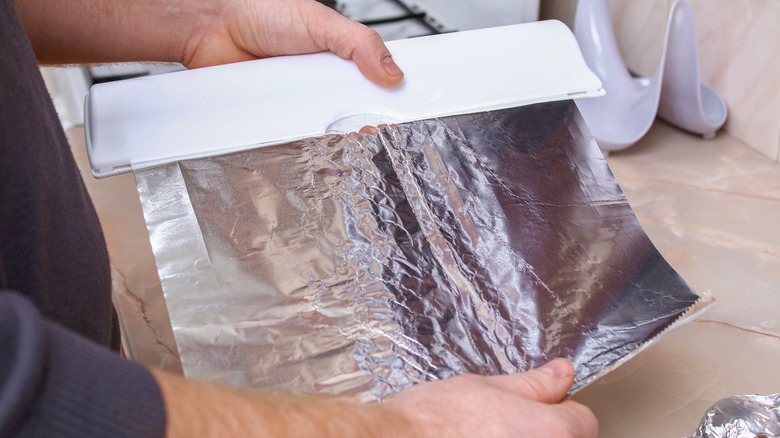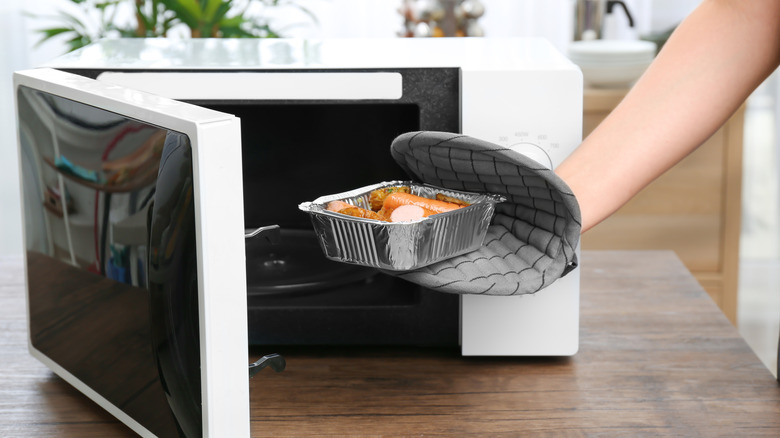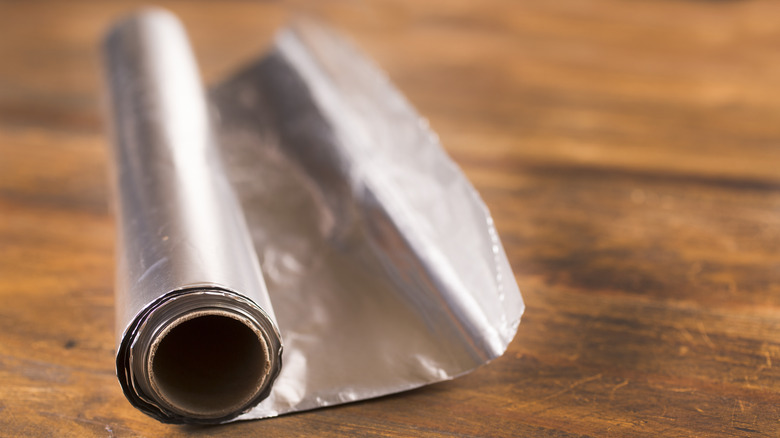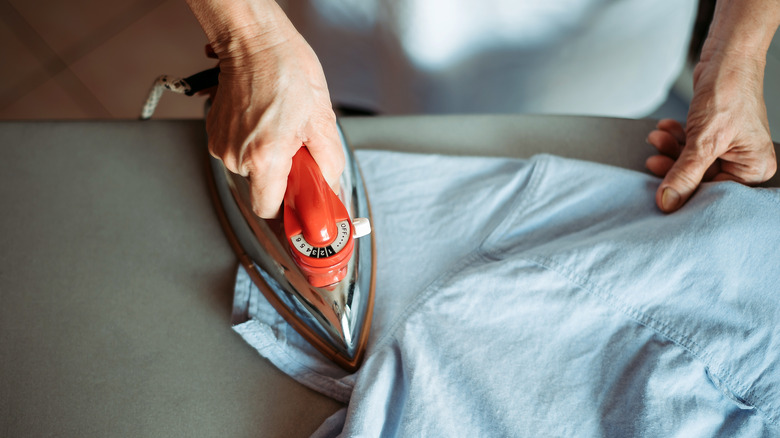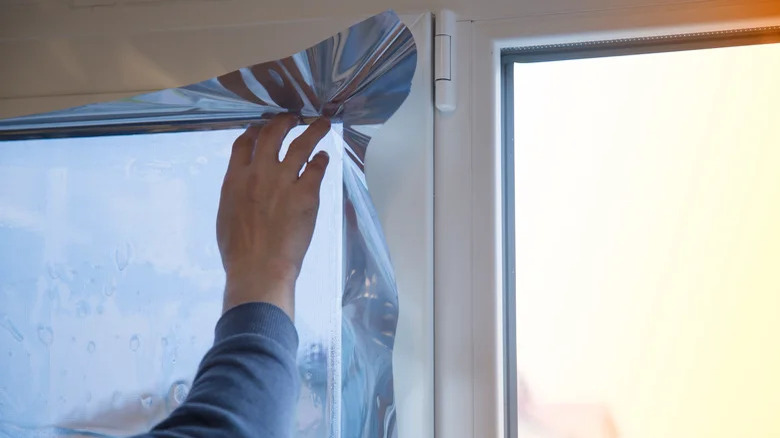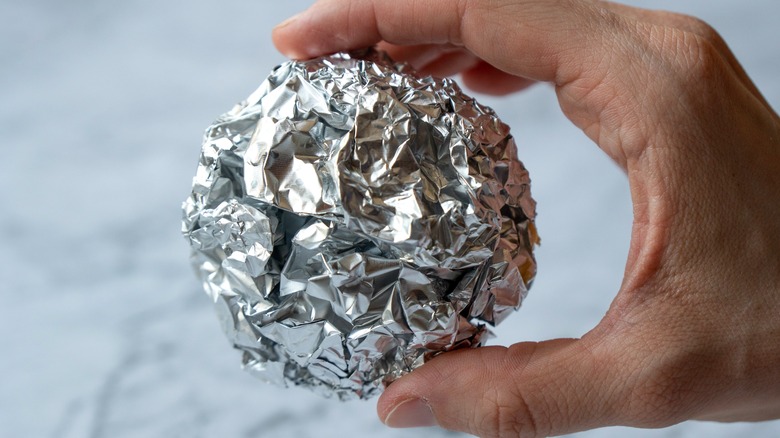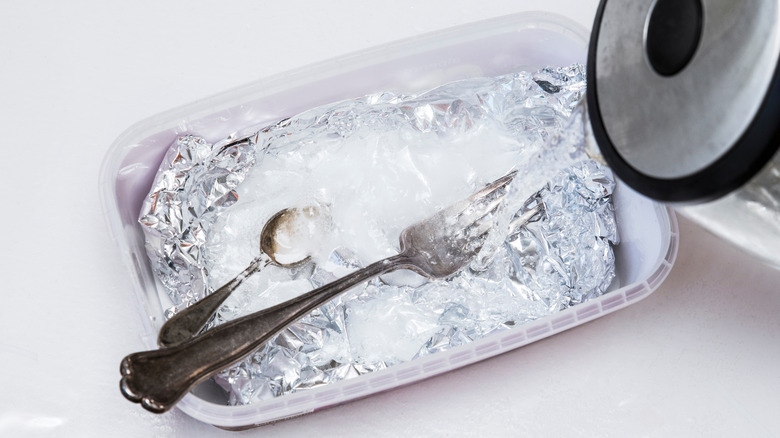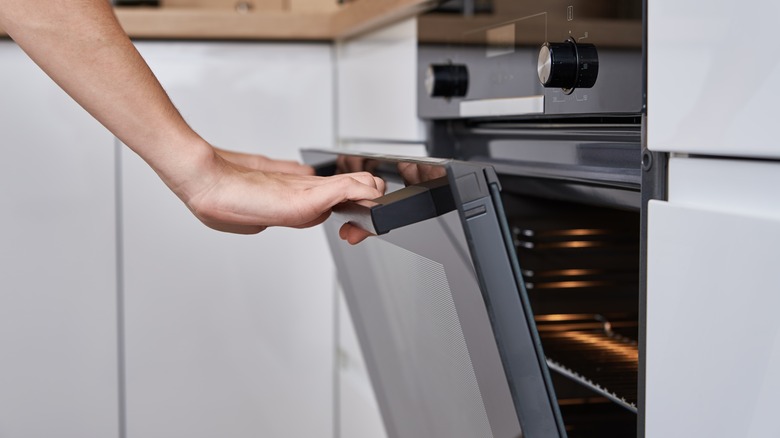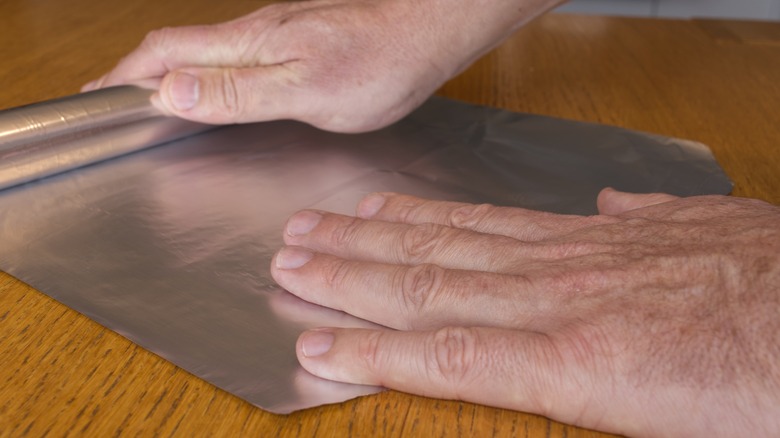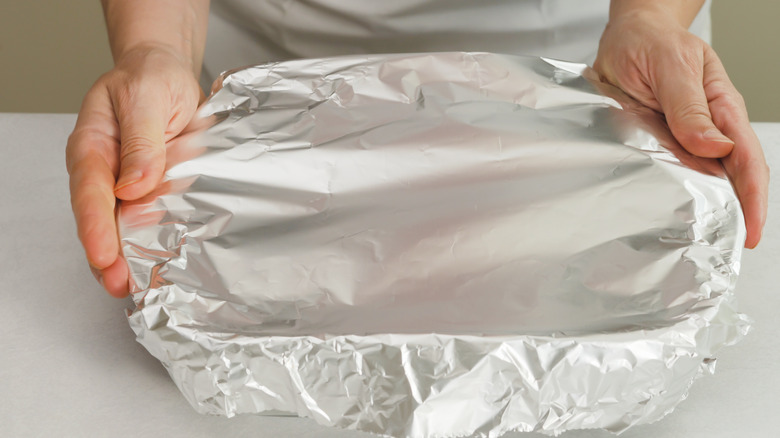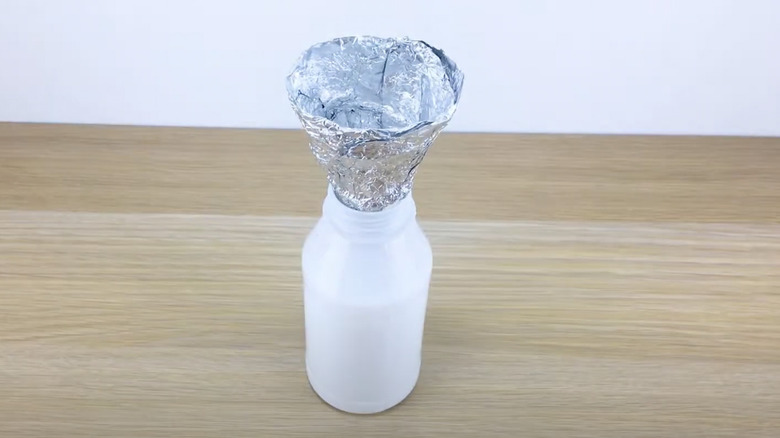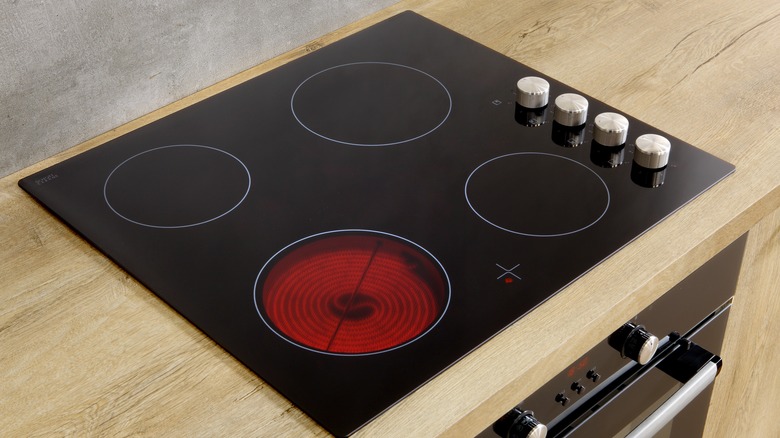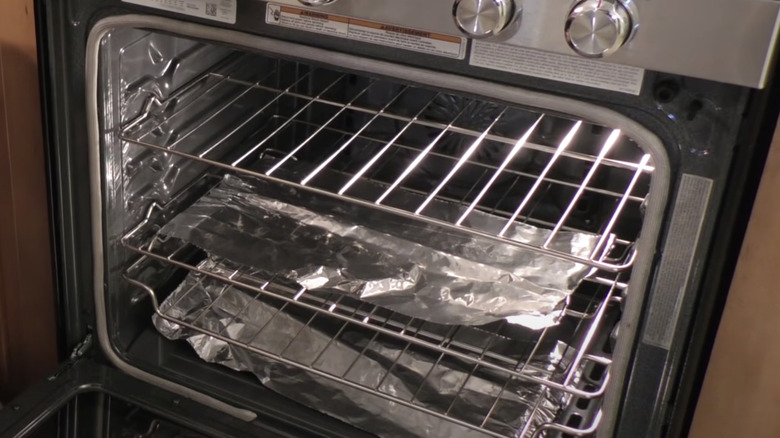Mistakes You Should Avoid Making With Aluminum Foil
When it comes to household essentials, few items are as versatile and ubiquitous as aluminum foil. Beyond its role in the kitchen, where it often aids in cooking, baking, and preserving the flavors of our favorite dishes, aluminum foil quietly offers its services in plenty of other ways around the house. You can use foil to rearrange the heaviest furniture without leaving a scratch on the floor, clean tarnished silverware without scrubbing, and even keep your laundry static-free. This unassuming yet invaluable tool has secured its place in the pantheon of multipurpose solutions.
Yet you are probably using it wrong. In fact, there are a few common mistakes that nearly everyone who attempts a tin foil hack makes that keep them from reaching the hack's full potential. Whether you're utilizing it for its reflective properties, heat-retaining abilities, or even its surprising uses in home improvement, avoid these mistakes to get the results you're after.
1. Placing foil in a microwave
The biggest mistake you could ever make with foil is placing it in a microwave. Even though you might often use foil to store food, always remove it from the container before heating it. Putting aluminum foil in the microwave can cause sparks and even fire. Microwaves warm up food by emitting electromagnetic waves that excite any water molecules present, generating heat through friction between these molecules. Aluminum foil, however, behaves very differently when exposed to microwave radiation.
Because aluminum is such a highly conductive material, it can cause electric currents to build up when placed in the microwave. These currents always lead to sparks. In particular, the foil's thin edges and sharp corners are particularly prone to sparking. In addition, sometimes its reflective nature can lead to a phenomenon called "arcing." This occurs when the microwave's energy is reflected off the foil, potentially damaging the appliance's interior or causing further sparking. If the foil's reflective properties direct the energy toward a specific spot in the oven, it can even cause a small fire to ignite. Many people place something in the microwave and walk away, leaving themselves and their kitchens vulnerable to harm.
2. Using thin or flimsy foil
Thin aluminum foil might tear easily, making it less effective to use around the house. Thicker, higher-quality foil generally provides better heat insulation and distribution. It is also easier to work with. Since this is why many reach for foil, it's best to avoid any thinner options. Flimsy foil may tear easily, leading to uneven cooking as only parts are covered. The tearing can also potentially expose food to direct heat, which leads to overcooking or burning. The same can be said when using thin foil to iron clothes, scour dishes, or even make a funnel. If you are using flimsy foil, you'll only be met with frustration as it will split right when you need it most — leaving you with a massive mess.
According to Aaluminum, most foil you can buy at the store is at least 0.006 inches and 0.072 inches thick. The thicker the better, so check the exact thickness on the back of the package before bringing it home.
3. Placing tin foil on top of clothes while ironing
You can place a sheet of aluminum foil under the ironing board cover to reflect heat onto your clothes, making ironing more efficient so it takes less time. However, a mistake most people make is placing the foil on top instead, thinking it will transfer more heat to the clothes. If the foil is above the clothing, you will just be ironing the foil. While it will likely look nice and shiny, nothing will happen to your clothes.
By placing foil underneath the ironing board cover instead, you leverage its high reflectivity. This allows the foil to bounce heat back up towards the underside of the clothes. As a result, it makes it so you can iron both sides of the fabric simultaneously. This way, everything goes faster because you don't have to flip the item over. Plus, you don't have to make the iron as hot when using foil. This conserves energy and minimizes the risk of scorching delicate fabrics sensitive to high temperatures.
4. Using foil to keep deer away from plants
Using foil to keep deer and other woodland animals out of your garden is a classic method, but it's easy to make mistakes when setting things up. Most people think that foil's bright, reflective nature will startle deer away when it catches the sunlight, but it doesn't. They also might think that the sound of foil clanging together in the wind will frighten them off, yet it also doesn't. This is because it's not bright enough to scare them, and foil doesn't make that much noise, either.
The only way to guarantee that foil will keep the plants in your yard safe from deer is to wrap your shrub or tree up in foil. This creates a physical barrier for the deer, thus keeping them from eating it. If it wants to eat the bark or leaves, it suddenly can't. However, you're better off using dear cages, which are much more effective at keeping these curious animals at bay.
5. Putting foil on the inside of windows
Foil on windows can be a temporary solution to reduce heat gain during hot weather. The trick works by reflecting sunlight away from the room's interior. This can potentially lower indoor temperatures. So if you don't have air conditioning, it's an easy way to cool down. Using foil on windows is also popular because it is easy to install. All you have to do is cut appropriately sized sheets of aluminum foil and attach them to the glass panes, usually with tape, but sometimes sticky tack works, too.
However, the key to this hack working correctly is putting the foil on the outside, not the inside of your windows. The reason behind this is that to bounce the heat away from your windows, the window shouldn't come into contact with the sun at all. If the foil is on the inside, the heat gets trapped between the pane and sheet, creating a greenhouse effect that will eventually leach heat into the room. To truly block the sun, you need the foil to be on the outside, where it can directly bounce the light away from the room.
6. Using too little foil as a DIY scouring pad
Most folks might already know that if you are in a pinch, you can use aluminum foil as a DIY scouring pad, replacing steel wool. If you are trying to create less waste, or just need some extra help getting rid of some tough grease, it's an amazing hack. However, most people are probably doing it wrong. One piece of foil isn't going to be enough to get the job done. The ball should be big enough to take up most of the palm of your hand — this way you don't struggle to use it and won't have to use as much elbow grease.
If you only have one piece of foil, it is also likely that you might make the ball too tight, as well. This might result in sharp edges that could scratch surfaces instead of cleaning them. The key is having a ball that isn't too loose and is made of multiple layers of foil. To avoid making mistakes here, either use multiple layers from the beginning, or simply set the bits you find aside until you've collected enough pieces for it to work.
7. Using foil to scrub tarnish off of silverware
Yes, foil can keep silverware tarnish-free, but not in the way you might think. A mistake people often make is trying to scrub tarnish off with tin foil. This is not a good idea as it is more likely to scratch the cutlery. Instead, you should use the foil sans any scrubbing. All you have to do is line a container (think a sink, cooking sheet, etc.) with a sheet of aluminum foil, shiny side up. Then, place the tarnished silverware on the foil, ensuring each piece directly touches the aluminum. Next, you should sprinkle a layer of baking soda over the silverware, making sure to cover all the items evenly.
To activate the cleaning process, pour boiling water over the cutlery. As the baking soda reacts with the aluminum foil, it will produce a chemical reaction that helps to remove the tarnish. It should begin to transfer from the silverware to the foil, revealing the polished surface beneath. Sometimes you might need to repeat the process a few times for the cutlery to be completely clean, replacing the foil each time.
8. Not securing foil in a convection oven
Using aluminum foil in a convection oven can pose serious dangers. This is because convection ovens circulate hot air around food, promoting even cooking. However, when you add foil to this mix and do it incorrectly, things can go pear-shaped quickly. If you place foil too close to the oven's fans, it can block the circulation of hot air. This can lead to uneven cooking and even cause the foil to heat up to the point of ignition. On the other hand, if you put it too close to the heating element, the heating rod can become damaged by overheating, causing an expensive fix.
As many home chefs prefer to use foil while baking and broiling, be sure to avoid the mistake of letting it fly free. If you use it, be sure it's weighted down by food or folded tightly around the corners of the baking pan.
9. Using sheets of foil to remove static from clothes
Using foil as a dryer sheet is a simple and eco-friendly solution. The practice reduces waste (as most people already have foil in the house) and reduces static cling without adding any scent to your laundry. However, foil can only reduce static cling as a ball; don't take the "sheet" part of the replacement option too literally. Just placing foil in the dryer won't do much on its own. That's because you need the ball to bounce around the appliance, allowing it to pick up excess electrons from one material and transfer it to another, reducing the static. If it's a flimsy sheet, it will likely just get plastered to the barrel of the drum or a large piece of clothing, or possibly tear and end up in your lint trap. For the best results, crumple a sheet of aluminum foil into a ball and toss it into the dryer with your laundry. This approach is particularly beneficial for fabrics prone to static, like synthetic materials like polyester.
Other key mistakes to avoid include overloading the dryer, as the ball won't have space to move around, or tightly packing the foil ball, which can hinder its ability to interact with the clothes and discharge static. Finally, ensure the foil ball is clean and free from food debris, as these could transfer to the clothes during drying.
10. Throwing foil away after one use
If you are looking for an easy way to go green, using foil again and again is one of the easiest ways to reduce the amount of waste coming out of your home. Keep in mind, however, that while foil can be reused, its effectiveness can also diminish over time. If you can't find a use for a worn-out piece, simply recycle it instead of throwing it away. Disposable foil trays and containers can often be recycled too, provided they are clean. If your local recycling program allows aluminum foil recycling, consider compressing it into a larger ball to aid in the process.
A mistake people tend to make when reusing foil is forgetting to clean it first. If you reuse it on different food or transfer it from food to a DIY project, this is particularly important. To do so, simply smooth out the crumpled bit of aluminum, run it under warm water, and wipe it gently with a sponge and a touch of dish soap. Stretch it out to dry on the counter, where it will be ready for use again within the hour. If you are in a rush, you can dab it dry with a dish towel.
11. Only using one sheet of foil as a funnel
If you don't have a funnel on hand, it's not an issue. You can easily shape aluminum foil into a funnel to transfer liquids (like household cleaners, leftover drinks, or even cooking grease) from one container to another. However, it only works if the foil is thick enough to support the weight of the liquid. If it's not, you will just end up with a huge mess on your hands. It would be a mistake to only fold one layer of aluminum around itself and expect it to go off without a hitch. Instead, always use heavy-duty aluminum foil and layer at least two to three pieces.
Instead of settling yourself up to fail, start by cutting a square or rectangular piece of foil. Fold it in half diagonally to form a triangle, then fold the triangle's edges together to create a funnel shape. You can adjust the size of the funnel's spout to suit your needs, but typically the smaller, the better.
12. Pairing foil with induction cooktops
Aluminum foil doesn't work with induction cooktops, as it can disrupt the magnetic field and damage the cooktop. Some people line their stoves with foil to keep them clean, but this can spell disaster for an induction stove. They work by generating an oscillating magnetic field just beneath the glass surface. This field interacts with the magnetic material in the base of compatible cookware, inducing electrical currents that, in turn, generate heat directly in the pot or pan. The beauty of this method lies in its rapid and precise heating, contributing to faster cooking times and energy efficiency.
However, introducing aluminum foil to this equation can quickly ruin it. Aluminum is not a magnetic material, so its presence on the cooktop disrupts the flow of the magnetic field. This disruption can lead to uneven heating. In some cases, the cookware might not heat up at all due to the foil's interference with the electromagnetic energy transfer. It can also cause the aluminum to melt, fusing it to the glass cooktop and ruining it. Even worse, it can possibly catch on fire, creating a safety risk.
13. Using the wrong side of foil when rearranging furniture
Aluminum foil can be a clever aid when rearranging furniture. It is easy to form into a DIY slider when moving heavy items around your home if you don't have any actual sliders handy. The foil's smooth surface helps furniture glide effortlessly across the floor, preventing scratches, scuffs, or dents. This technique is particularly beneficial when dealing with heavy items like sofas, tables, or cabinets, as it reduces the friction between furniture and floor, making maneuvering less strenuous. However, you're making the job harder if you use just any side of the foil. It turns out that the dull side is much slippier than the shiny side, so that should be the part facing down to the floor or carpet.
To do things properly, cut sheets of foil and fold them into small rectangles. Next, place them under the furniture's legs or edges, dull side down. This will help it glide easier, taking pressure off your back and ensuring you won't scratch your hardwood or tiles.
14. Placing foil on the bottom of the oven
Unfortunately, placing foil on the bottom of the oven can indeed lead to overheating and cause other problems. This is a bummer because most of us place foil there to catch drippings so we don't have to clean it as much. However, it is a highly reflective material, and when placed on the bottom, it can reflect heat up toward the oven's coils and walls. This reflected heat can disrupt the oven's temperature regulation and distribution, potentially causing it to overheat.
Even though having foil in the oven is convenient, it is a mistake not to be aware of the risks. This is because overheating can lead to many issues, like damage to the oven's thermostat. This results in costly repairs and decreased oven lifespan. Plus, interfering with its temperature regulation can result in inaccurate temperature readings, making it almost certain you will burn your brownies. And no one wants that.
